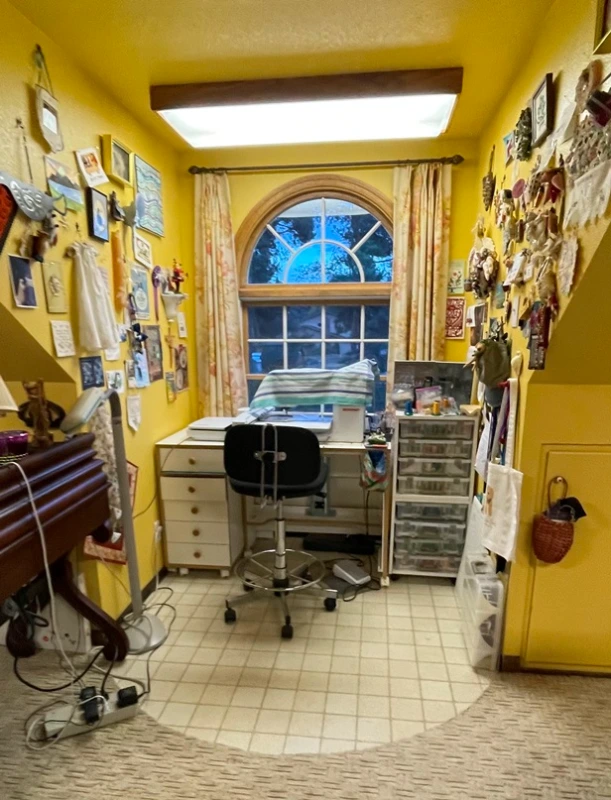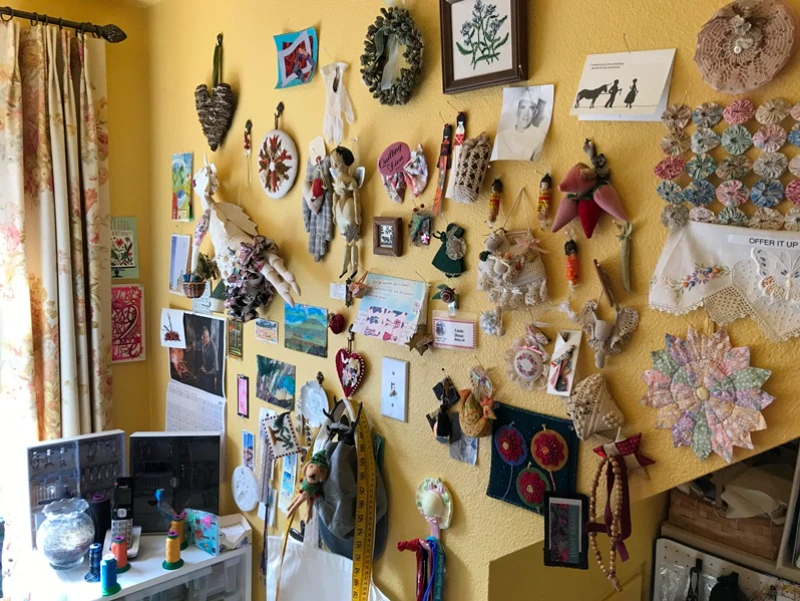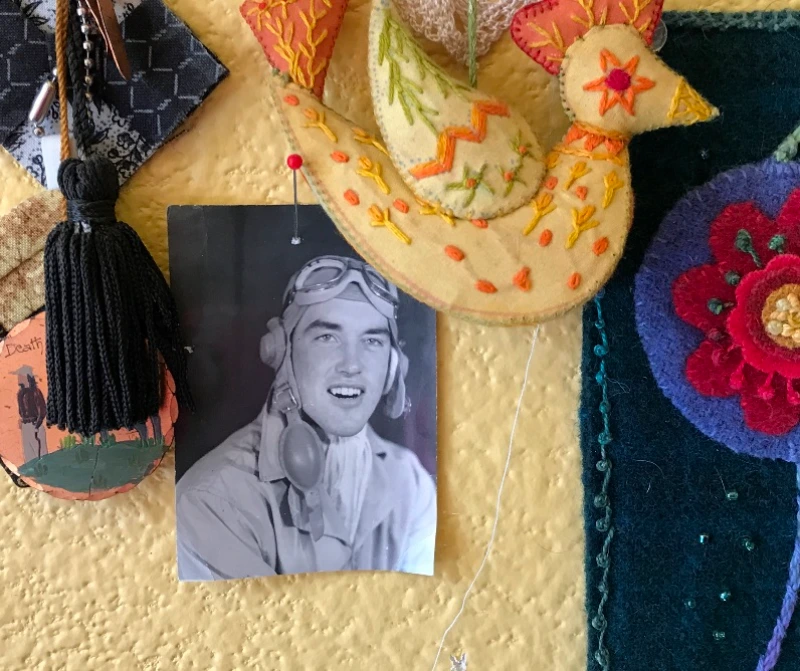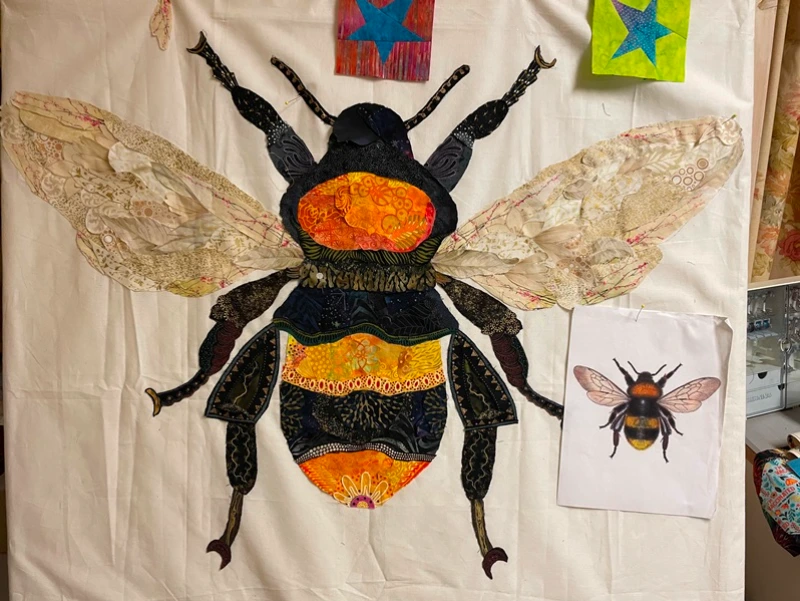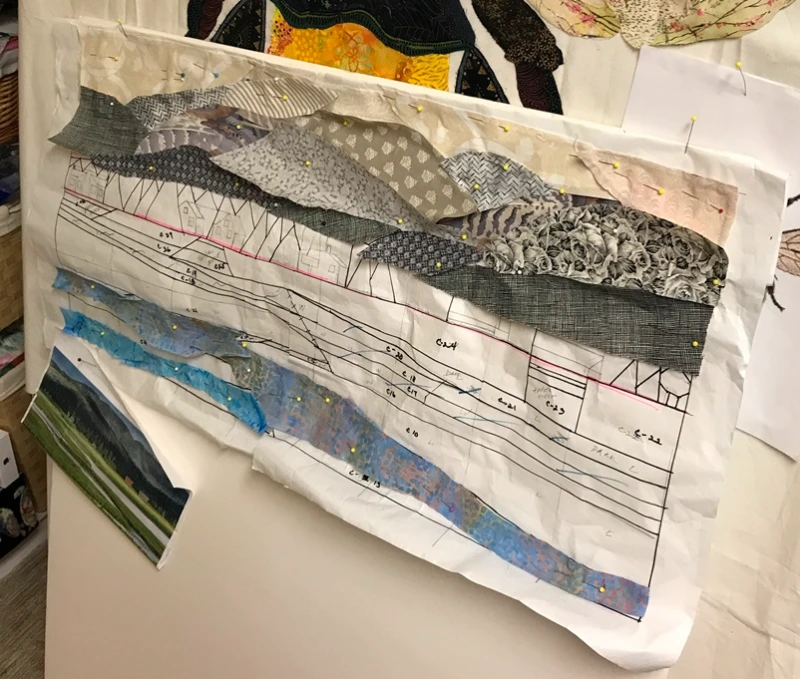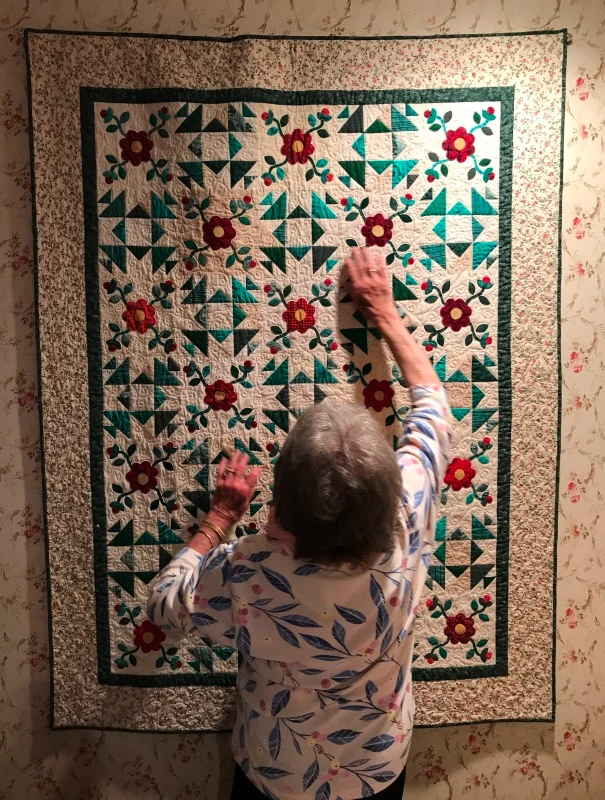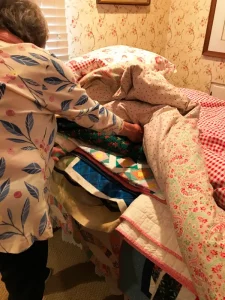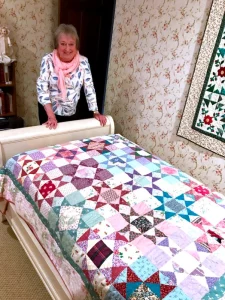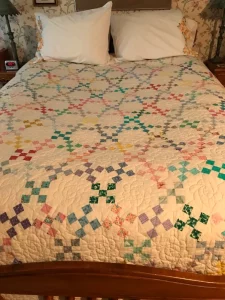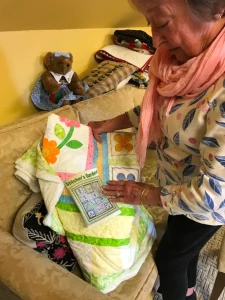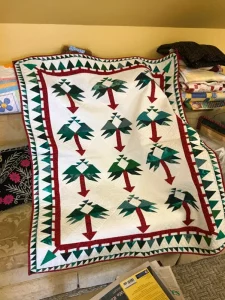ARTIST STATEMENT
lindafdixon@msn.com
“I am a native Idahoan, born in Boise and raised in Nampa. I began embroidering at an early age and started teaching needlework and quilting in 1980. Along with Jo Inzer, I started the local chapter of Embroiderers Guild of America which led to the founding of Boise Basin Quilters. I was the owner of the Bernina Dealership along with Patty Hinkle for 10 years. Textile arts are my passion. I have made so many dear friends through this medium. It is a rare day that I don’t spend at least an hour in my sewing room doing something with needle and thread.
When we travel, I am always on the lookout for needlework or quilt shops and any museum or art gallery that features textile artists. I have seen some amazing antique and contemporary works. It all has contributed to my love of the medium.
My husband, Tom, and I have two children, a son-in-law and a darling year-old granddaughter. We also share our home with two funny dogs.”
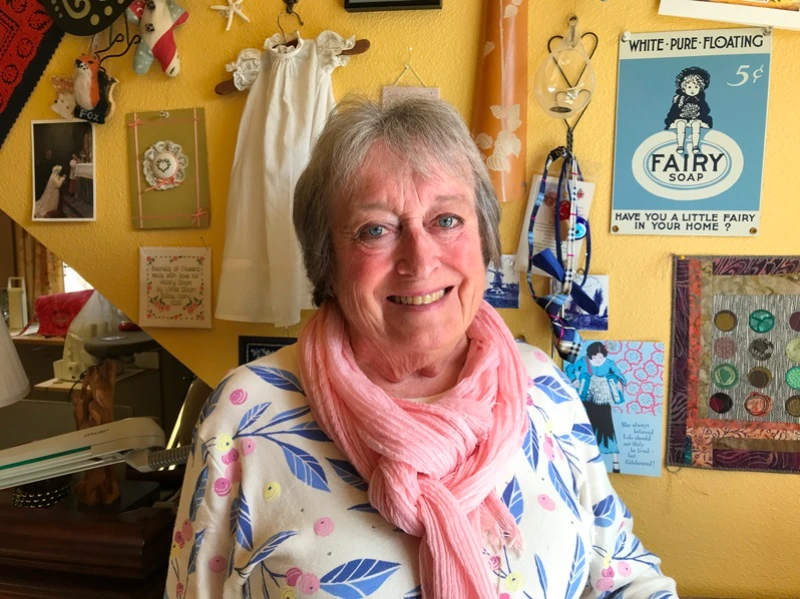
Article & photos by Vicki Francis
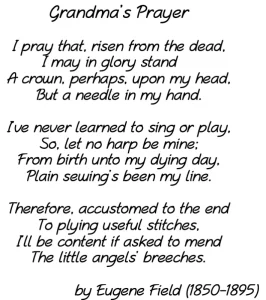
FEATURED QUILTER INVITATION
When she was invited to be the featured quilter in the BBQ show, she said, “I was gobsmacked! Totally flattered!”
She anticipates having at least 20 quilts in the show. But she needs to gather her quilts from her children, siblings and friends as they were all made to be used.
“I didn’t make quilts for the Smithsonian, I made them to be slept under,” she said. Hopefully, as she “borrows back” the quilts they will all be in “good enough shape!”
She still loves making quilts and, in the future, “I’ll just keep sewing! I can’t stop! I love the fabric and the sewing…I just see myself continuing on!”
IN HER STUDIO
In a house built by her father in 1980, Linda Dixon’s studio occupies the space above the oversized two car garage. The area was originally to be trusses. However, her father, Jim Flitton, suggested that the space could be stick constructed, closed in and used for her studio. With his suggestion of adding a dormer for extra light and measuring it to fit her sewing cabinet, it was finished as a spacious, yet cozy area where her creativity has been cultivated for over the past 40 years.
The dormer hugs her Bernina B780 with two walls that feature numerous curiosities such as quilted and embroidered items, photos, cards, tatting and dolls.
“These are things I have found interesting, people have given to me, especially from really good friends,” she said.
A large window behind the machine has a panoramic view of the back yard as a beautiful natural light filters in. Two photos of her father watch over her. An aviator in WWII stationed in Florida, he trained pilots to land on carriers out at sea. His job included following pilots out to the carrier and ferrying them back to land. Though he never fought at sea, he made hundreds of safe carrier landings training those that did.
“I adored him,” she said.
A large TV is used to “listen” to television shows and play classical music while she is working. There is a yoga pad for the goal of doing yoga at least twice a week and a large collection of puzzle boxes. When Linda would lose the motivation to sew during the pandemic, she would work on puzzles to occupy her mind.
She found the pandemic very stressful, especially with fears for her daughter who was pregnant with her first child. (Her 13-month-old granddaughter, Evelyn, was born healthy and is a “very happy child!”).
On a nearby easel sits an art quilt started at an “Empty Spools Seminar” with Linda Beach in California. A photograph of Henry’s Fork of the Snake River looking across at the Railroad Ranch inspires the creation. The method of using freezer paper templates with straight edge piecing and slight curves in the style of Ruth McDowell.
The quilt sits in front of a large bumble bee art quilt started in a Susan Carlson class.
photos by Linda Dixon
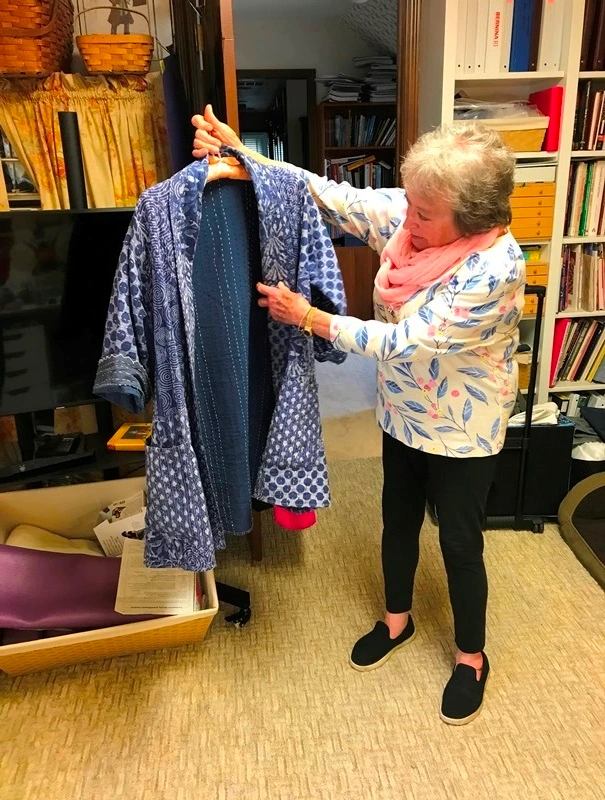
VOLUNTEER WORK
She is very active in Artisans for Hope, an organization dedicated to teaching refugees’ basic skill development for employment and entrepreneurship while training them in making and marketing handcrafted items. One focus for her has been creating swing jackets. She created the pattern by deconstructing one of her jackets and modifying it. The group purchases kantha quilts that she sews into beautiful, colorful swing jackets that are sold on their website: www.artisansforhope.org
She said, “We have sold a lot of them!” Other retail locations for the group include, Rediscovered Books in downtown Boise (www.rdbooks.org), The Mixing Bowl (www.themixingbowlboise.com), and Dunia Market Place in Hyde Park (previously known as Ten Thousand Villages) (www.duniamarketplace.com)
Rediscovered Books has allowed the organization to put up a table outside their store during Farmer’s Market on Saturdays in downtown Boise.
She said that working for Artisans for Hope, “… feeds my soul. I have always said, ‘these are the bravest people in the world, they leave everything and then come in the hopes that somebody will support them.”
FOUNDING MEMBER OF BOISE BASIN QUILT GUILD
Linda began working at a needlework shop, Stitch Craft Studio, which opened in the 1970’s and was owned by Mary Jo Sanders in downtown Boise. Besides her mother, Linda feels that Mary Jo, “taught me more about textiles and needlework than anyone I ever met. She was an incredibly talented woman.” The shop closed about 1983. A special gift to Linda from Mary Jo hangs in Linda’s bedroom.
In 1987 the shop Quilt Crossing opened where she began teaching classes. Patty Hinkel was approached by Bernina to open a dealership in the store and Linda partnered with her. When they first started, Patty said, “I will do all the books and paperwork, but you have to figure out this embroidery thing!”
Linda said, “I love to embroider, I absolutely love it.”
But the only thing Linda had ever seen were things that looked like Mickey Mouse badges that were hard as a board with 1000 stitches per inch. Once she began playing with the machine embroidery, she wanted to make things that looked hand made.
BEGINNINGS OF A GUILD
One day a woman came into the studio and said, “I am Jo Inzer Smith and I just moved here from Texas and I want to start a quilt guild.”
Linda wanted to start a local chapter of the Embroiderer’s Guild of America but never found anyone else who was interested. They started the local chapter (www.egausa.org) and met at the Boise Public Library. Jo started an interest group for quilters. Linda thought it was a good idea, but thought that “I’ll probably never make a quilt!” Then, with a smile on her face today, said, “Never say that!”
The quilt interest group became a large part of the guild and wanted to move the quilt group forward. They sponsored a quilt show at the Idaho Historical Museum that included quilts from the museum’s collection.
About 1983, the quilt group decided they didn’t want to be part of the Embroiderer’s Guild as they wanted to be their own guild. That became Boise Basin Quilt Guild with the Articles of Incorporation dated October 28, 1986.
Jo has since passed away. Linda said, “She was an incredible craftsperson!”
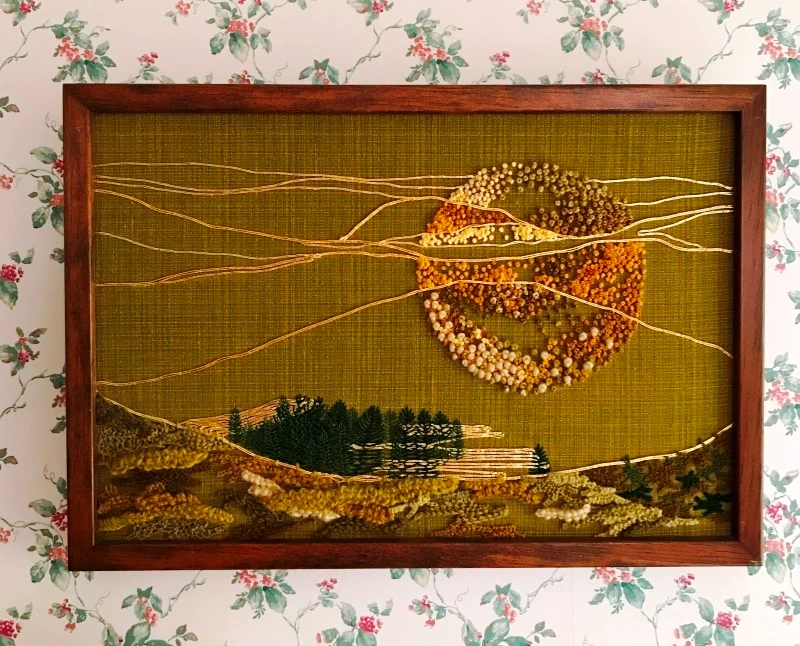
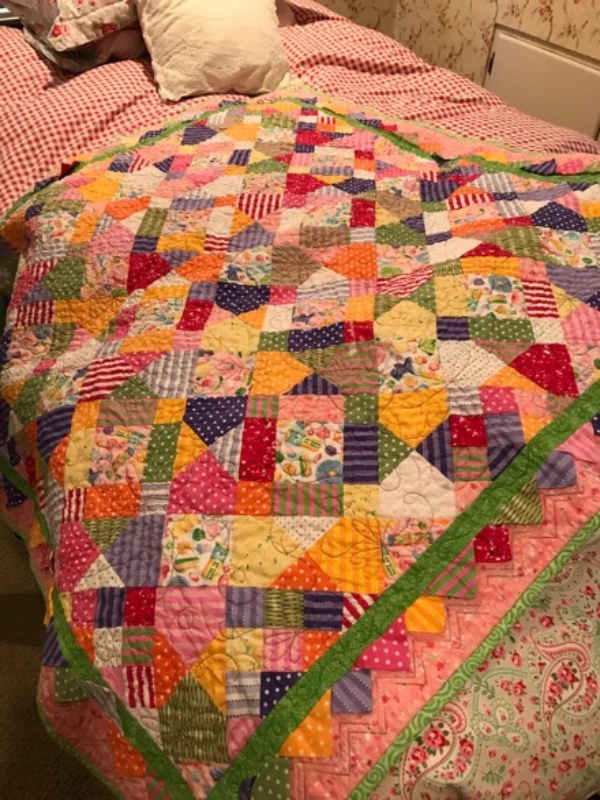
FEATURED QUILTER AT 2022 BOISE BASIN QUILT GUILD SHOW
Making her list of quilts to exhibit as the featured quilter at the 2022 BBQ Quilt Show, Linda peels through her “storage”- about a 12 inch high pile of quilts on a bed (she doesn’t like to fold them) in her daughter’s old bedroom where Evelyn now sleeps in a crib when they visit. There are several show quilts under consideration.
One was a sample she made for Quilt Crossing and is a patchwork of pinks, purples, yellows, greens and cream with an echoed prairie points border with a flower and swirls quilting motif.
She said, “I think it’s the happiest quilt I’ve ever made.”
Hanging on the bedroom wall is a floral appliqued quilt that she made with another BK mother, Mary Ann Williams, as a donation to the annual auction at Bishop Kelly High School. Her son bid on it, won and gave it back to her as a gift.
On the bed by itself is a very special quilt made with her sister, Kathy Sunada, at a class with Navy wives at the Pearl Harbor Naval Station in Hawaii. They were the only non-military women there. The instructor, Mary Penders, was “the most obsessive, compulsive person I have ever met in my life. If you were making a two-color quilt out of solid fabrics, she wanted all the grain lines to go in the same direction!”
Her sister had a business where she manufactured ladies clothing and she had a “chickadee”-a motorized rotary cutter that cuts through multiple layers of fabric. The other women came with carefully selected fabric arranged in stacks of tonal colors. Linda and her sister went to the class with garbage bags full of cutaways.
“There was nothing nice about how we brought our fabrics. The fabrics are dated-from the 90”s but “it’s such a wonderful quilt and there are such good memories,” Linda said. “We made two quilts, they were companions and we said, ‘When we got to the nursing home together, we would have matching bedspreads!’ They [the quilts] only have one block that is exactly the same, but we made them together.”
In another bedroom is one of her favorite quilts and a hand-quilted creation. A solid cream Jack Straw patterned quilt with a myriad of colorful squares. She considers it a traditional quilt with untraditional piecing methods.
“It’s complicated. It looks like it has so much movement and it’s all straight line,” she said.
Another show possibility is a sample made for the Quilt Crossing called, “Stitcher’s Garden.” The blocks were machine stitched then appliqued. Many different “fancy stitches” were then used to encourage the students to learn different stitch types and lengths.
Another quilt features multiple fabrics to form strong green pine trees on a white background with intricate hand-quilted feathers in the white negative space. The pattern is #1398 “Tree of Life” as found in “Encyclopedia of Pieced Quilt Patterns” by Barbara Brackman page 185 (Second Edition) and page 165 (Third Edition).
“I love scrap quilts. I never want to make a quilt with two fabrics in it…I want at least 25 fabrics.” she said.
She made the blocks then added her own border pattern of smaller trees with a sawtooth border. The quilting pattern came from a book that she modified to fit the spaces.
Ironically, she doesn’t have a quilt on her own bed because the dogs sleep there. She’d rather that they did not, but her husband has outvoted her!
Vicki Francis
Writer and Photographer
Vickifranciscoaching@gmail.com
